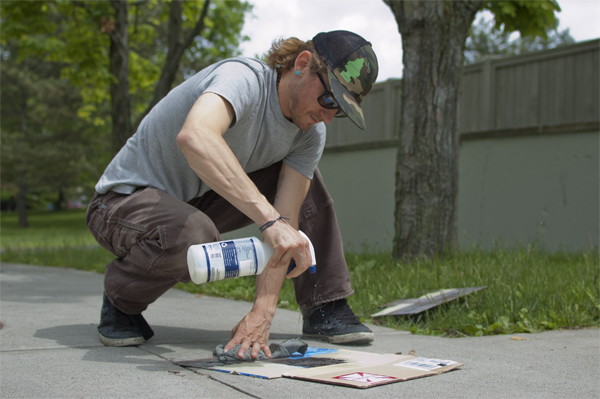

In light of the recent exploration of re-enforcing smoking zones on campus, one graduate student has decided to mark them with an artistic approach.
Todd Martin, a first-year printmaking graduate student, used an assignment in his photo silkscreen class to draw liquid chalk installations in front of the Fine Arts Building, Smiley Art Building and the Sojourner Truth Library that would highlight the zones next to building entrances that are smoke-free areas.
“I wanted to draw attention to the 50- foot smoke-free zone around the entrances because I didn’t know if people were aware of the area or even the distance,” Martin said. “I feel privileged in having the opportunity to have my work showcased on campus.”
Outside of each of the building’s entrances, Martin used stencils to draw white daffodils and the words “smoke free zone” to fulfill his assignment of printing on a three-dimensional surface.
“I used white daffodils because they are the flower of lung cancer awareness,” Martin said.
Director of Environmental Health & Safety Mike Malloy said Martin’s graphics would be a good way to highlight the recent attempt to remind students of the smoke-free areas around campus.
“Anything to help people understand the campus smoking policy is a good idea,” Malloy said. “If we can express it through the talent of our students, even better.”
Sen. Jonathan Espinosa, one of three senators who spearheaded a project to look into different ways to curb smoking in prohibited areas earlier this semester, said he was unaware of Martin’s project; however, he thought it was a “great” way to raise awareness.
“I think the use of art to help solve any political issue is powerful, creative and appealing,” Espinosa said.
Despite positive reactions from campus staff and student senators, Malloy said the Office of Facilities and Design is still debating the best way to incorporate delineation of smoking zones because they are not sure how the policy will change in the next few years.
Malloy said some campuses have implemented an entirely smoke-free policy while others have designated smoking areas.
“We could change the policy in a year or two, so any kind of permanent marking might not be the best idea, but…that is not my decision,” Malloy said.
Martin said because the installations were liquid-chalk based, he wasn’t sure how long they would last outside of the buildings because of weather conditions, but hoped he might be able to work on them more in the future.
“It would be great if I could get commissioned to do more on campus, or make a permanent one,” Martin said.
Other options to better enforce the campus smoking policy are being explored, including moving cigarette containers farther away from building entrances, but nothing has been set in stone yet, Malloy said.
“We are looking always to improve our campus policy for the betterment of our community,” Malloy said. “We all have a responsibility to ensure folks are not smoking too close to buildings. We need to have one voice, if we ignore it, then we as community members are just as guilty as the smokers who are smoking too close.”
